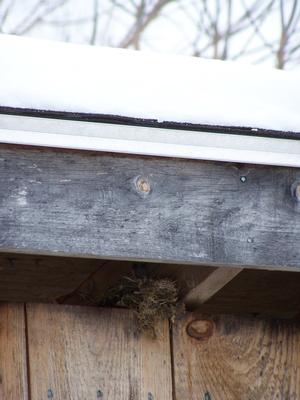Part VIII: Phoebes, Hummingbirds and Blue Jays
In Parts VIII and IX of an Exaltation of Larks I am highlighting four birds with which I have personal connection. I have great affection for the gentle vigilant Phoebes. In their simple, clear two-toned voice, the first note higher than the second, they sound their namesake, “FEE-bee”. We always delight upon their spring arrival. Alit upon any suitable vantage Phoebes scour the landscape for nutritious insects. They are of enormous help here at Quackin’ Grass feeding upon so many of the insects that would feast upon plants, both in containers and gardens. In colder months they devour berries as do many insectivores when insects are few.
Often Phoebes choose sheltered platforms under eaves or on beams in open buildings where they construct mud and grass nests lined with moss and hair (see pic 1). Dutiful, they trade turns, hunting and overseeing their family. They may successfully raise two broods each season. In 2007 a breeding pair had two of their nests savaged by a night-marauding creature, the incidences but a few weeks apart of each other. Dr. Craig surmised the culprit was a Flying Squirrel - they are much more common than most people know. The couple built their third nest in a different, more cloistered site. With fingers crossed the pair finally raised a successful brood. What a relief! In family tradition offspring will revisit the same location in successive years refurbishing a tattered nest before attempting a new generation.
The beloved Ruby-throated Hummingbirds, the flying jewels are a favorite of many. Though hummers visit many flower styles and colors they are especially drawn to trumpet-shaped florets in the red color spectrum flitting from one to the next while tirelessly sipping nectar with their long flicking tongues (see pic 2).
Hummingbird feeders come in many styles. Follow the directions carefully when making the sugar water that they so love. Caution: feeders must be kept pristinely clean because bacteria will quickly grow in these vessels which can sicken and kill the very birds you want to help.
It’s always fascinating when competing hummers cross paths. For their small size they are surprisingly pugnacious. Vying for territory one will threateningly swoop back and forth in a wide bowl-shaped arc over the head of the perceived perched trespasser.
Nearly every summer several become trapped in my small greenhouse. Hummers consistently look up seeking a way out rather than down towards the open doors. I’ve learned that an easy ploy is to place potted plants with red flowers at the front and rear entrances of this small enclosed structure. Once they’ve spotted the red flowers they fly down and suddenly find their way out to the greater world. Occasionally, I have happened upon a trapped Hummingbird in a terribly weakened state. Hurriedly, I make a sugar water solution and pour it into a jar lid. Carefully, I poise the tip of the bird’s beak into the sweet sustenance. The poor little birds, nearly starved, suddenly begin to drink. And they drink and drink! Finally, once he has sipped his fill and looks brighter I set him upon a platform. In moments when he gains his strength and composure he looks all about and bright-eyed, flies off. Those are close calls!
Blue Jays (see pic 3) dressed in their handsomely marked blue, gray, black and white feathers are bright, aggressive and sharp. We have Blue Jays nesting in a wild red cedar grove on the knoll west of our barn. Blue Jays are not necessarily associated with conifers though I remember well as a child a row of tall Norway spruce (Picea abies) in which they nested annually. And I guess it was because they were so distractingly loud that I took notice! It’s hard to miss their piercing cries of jay-jay.
Though Blue Jays often nest in conifers they are drawn to oaks. Interestingly, Blue Jays are the proverbial Johnny Appleseeds among the feathered frequently burying acorns and seed which is never retrieved hence supporting new generations of plants. Some sprout and grow into future mighty oaks which in time provide for raucously loud distant generations.
They have adapted well to suburban situations and even city parks where oaks flourish. Often the Blue Jays spotted in winter are those who summer farther north. Our summer residents migrate in loose flocks to more southerly climes when temperatures cool returning the next spring. This pattern holds true for many different species.
Both American Crows and Blue Jays harass hawks. I’m not sure if they perceive hawks a threat to their young or potential competition to overlapping food sources. Maybe it’s for sport. But every year on numerous occasions I see them in flight chasing hawks. And when the hawk perches so do the birds that have been pestering him, squawking or caw-cawing all the while. To be continued…


